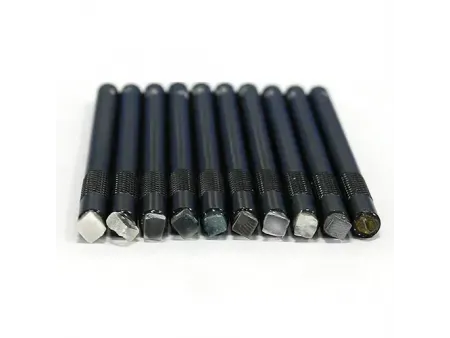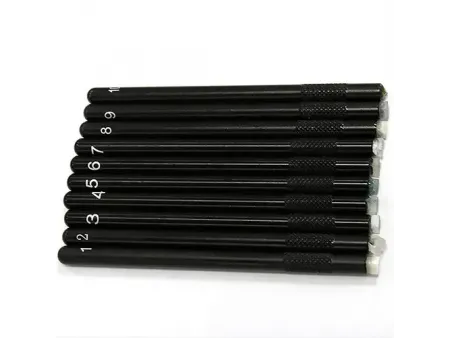Mohs Hardness Pencil
Hardness is an important factor in determining a gemstone’s durability and resistance to scratches, pressure, and abrasion. When two minerals of different hardness levels come into contact, the softer one will show visible scratches. The Mohs hardness pencil is a practical tool for testing hardness by comparing a gemstone's resistance to known reference minerals.
Mohs hardness pencils are used to assess a gemstone's hardness by gently scratching its surface. If a visible mark appears, the gemstone’s hardness is lower than that of the testing pencil, making it a useful tool for quick hardness evaluation in gemology and mineralogy.
| Model | | | | |
| Quantity (pcs) | Total: 5 pcs No. 5: 1 pc No. 6: 1 pc No. 7: 1 pc No. 8: 1 pc No. 9: 1 pc | Total: 6 pcs No. 4: 1 pc No. 5: 1 pc No. 6: 1 pc No. 7: 1 pc No. 8: 1 pc No. 9: 1 pc | Total: 8 pcs No. 3: 1 pc No. 4: 1 pc No. 5: 1 pc No. 6: 1 pc No. 7: 1 pc No. 8: 1 pc No. 9: 1 pc No. 10: 1 pc | Total: 10 pcs No. 1: 1 pc No. 2: 1 pc No. 3: 1 pc No. 4: 1 pc No. 5: 1 pc No. 6: 1 pc No. 7: 1 pc No. 8: 1 pc No. 9: 1 pc No. 10: 1 pc |
| Weight | 170g | 180g | 190g | 205g |
| Single piece size | 104 × 6mm | |||
| Single piece weight | Approx. 7g | |||
| Packaging size | 170 × 120 × 35mm | |||
| The Mohs scale is divided into ten levels, each corresponding to a specific reference mineral: talc (1), gypsum (2), calcite (3), fluorite (4), apatite (5), orthoclase feldspar (6), quartz (7), topaz (8), corundum (9), and diamond (10). | ||||
- Estimate the hardness visually first
Before using the hardness pencils, observe the sample and make an initial visual estimate of its hardness to determine a starting point for testing.
- Testing on an inconspicuous area
Begin by using a hardness pencil rated 1–2 levels lower than the estimated hardness. If the pencil does not leave a scratch, the sample is harder than that level. Gradually move up to a higher-rated pencil, repeating the process until a faint mark appears, this indicates the sample's hardness is close to that level. If a clear scratch is made, the hardness is lower than the pencil rating. Apply moderate pressure during testing; excessive force or too little force can lead to inaccurate results.
- Testing mounted gemstones
Hardness testing through scratching is not recommended for set gemstones, as it may damage the jewelry or affect its appearance.
- Hardness testing as a supporting method
The hardness pencils provide a relative hardness assessment and should be used alongside other gemological tools such as polariscopes, microscopes, refractometers, and UV fluorescence lamps to verify results.




